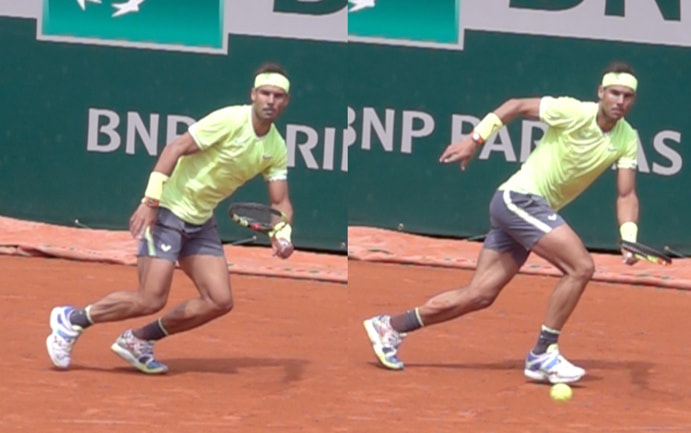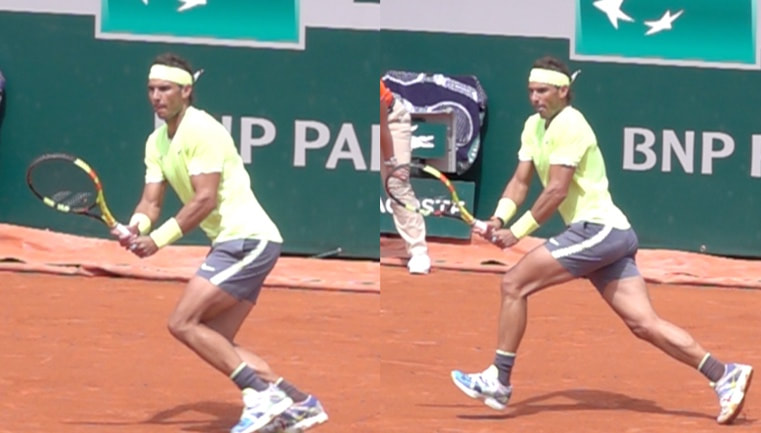Author: Doug ENG EDD PhD, MTPS and BharaThan Sundar
Over and O’Donoghue (2008) have suggested that movement training often be carried out without accurate knowledge of physiological, technical and biomechanical requirements. Instead, coaches and coaches should consider the consequences of research and data. Approximately 70% of the tennis movement is lateral and 20% of the tennis movement is forward (Weber et al., 2007). It is estimated that the average professional in clay courts lasts only 5% of shots where the distance> 4.5 m (Ferrauti and Weber, 2001). Richers (1995) found that the average number of continuous steps to the ball was 5.4 in hard courts and 5.7 in clay or grassy courts. Steps may vary in step length depending on the speed, distance and time of the assembly. Over the past 25 years, rally speeds have increased, which could affect the lengths of steps and the number of steps. Si.com (2015) staff watched the movement of 4 ATP players and found that their movement per point was 8-14 m, depending on the position of the court, the style of playing and the length of the rally. At the Australian Open 2017, the average assembly lasted 4.47 and 4.85 shots and 5.44 and 5.93 s for women and men (Carboch et al., 2018). In addition, selected ATP players (n = 34) and WTA (n = 44) from September 2019 to September 2020 had an average rally length of 4.21 and 4.06 shots with an average player range from 3.2 to 5.4 (Sackmann , NDA; Interpretation times and Inter-Bod have been reported in 29-30 s (O’Donoghue, & Liddle, 1998), but recently it is stated that the actual time to point to point changes about 25-45 SV dependence on individual athletes (Bialik, Bialik, 2014; The data can be estimated that it occurs at 4.5 m every 3 to 3.5 minutes.
Although rarely occurs> 4.5 m, high acceleration and slowdown are more often. Hoppe et al. (2014) found that the top speed speeds for adolescents (12-14 years) were 4.4 ± 0.8 m/s (9.8 mph). Players exceeded 3 m/s (6.71 mph) every 5 minutes or only 18.5 times per match. High acceleration and slowdown were defined as 2.0 m/s2 (or 6.56 ft/s2). High acceleration and slowdown were 51.7 and 47.0 times per match, each or 0.6/min. The high acceleration was 51.7 per match of 0.6/min or once every 1.7 minutes, twice as often as running distance> 4.5 m, as reported for professional players. Typical highest speeds for ATP Pro are 15-16 kmh and for the WTA PRES is 13-14 kmh (Game Inside Group, Tennis Australia, 2016). Novak Djokovic reached 36.02 kmh (22.38 mph) for sprinting> 3 m.
Obviously, the initial acceleration is more important than the upper or maximum speed. In addition, foresight hints can optimize movement and reduce acceleration requirements by responding earlier. However, technical training on legs should include training one -sided explosiveness to improve strength development rate (RFD). At an interval of 5 – 10 m, an athlete can reach an estimated 70% of the highest speed (Duthie, Pyne, Marsh and Hooper, 2006). Therefore, most athletes reach about 70% of the upper end speed. 36.02 kmh Djokovic was probably 80-85% of its highest end speed, but the distance could exceed 10 m.
In short sprints, a combination of vertical and horizontal power components (Dintiman, G, 2020; Jeffries, 2017) is applied. In the initial phase of the 0-5 m acceleration, the horizontal speed component is more important than the vertical component. For the maximum upper speed, the most important determinant is ground force (Weyand et al., 2000). The first 3 steps from standing or still positioning include mostly horizontal power (DintiMan, 2020). At a maximum linear speed, the first -class Sprinter and Frequency of 2.6 mm of 5 steps/s (DintiMan, 2020; Mann & Murphy, 2018) reaches. The side acceleration has the length and frequency of lower steps. Interesting is the acceleration of top professional tennis players.
Side acceleration of Djokovic and Nadal
Novak Djokovic is probably the best movement on ATP tour today. Rafael Nadal is considered one of the best contracts of all time. In this case study, 40 plots were examined (Nadal = 18, Djokovic = 22). The high speed of 120 and 240 FPS HD videoography was filmed using the Sony 4K RX10. Speeds and acceleration were estimated at 0.05 s increments from T = 0.00 s to 0.35 s. The measurements were made with a head/arm shift. T = 0.00 s begins at the end of the split step when the head/shoulders begin to move laterally. It was found that the acceleration at each interval of 0.05s has been constantly increasing or decreasing, but depended on the force of the production (RFD) from any foot.
On wide balls, Djokovic can usually achieve steps of steps 2 mA and the frequency of 4 steps/s steps. As already mentioned, the acceleration in each increment of 0.05 seconds was not uniform but dependent on the one -sided RFD. The athlete may initially be squeezed unevenly from one leg, as the one -sided (ie individual) leg strength may not be the same force. In addition, the leg drives are in different stages such as take -off or landing positions. Therefore, the acceleration measured for Djokovic and Nadal did not include a permanent RFD.
Figure 1a (left). Rafael Nadal 0.217s and 0.379s after the initial acceleration in the case of 2, which moved to the forehead. 1b (right). Rafael Nadal 0.288sa 0.413 s after the initial acceleration in case of 3, which moved to the back.
It is reasonable to assume the same terms to the extent of power production and the ground force response is paid in the side direction as a linear speed. In the side movement, most of the force is generated by the outer leg, which is further from the intended direction. After a stroke, slowing down to enforce a favorable judicial position requires the legs to change the tasks where the left leg is the outer leg of the external foot while the explosive movement towards the ball. When the athlete moves back to the center or right, the left leg is the outer leg in the change of direction (COD) or the recovery phase.
Tennis players could be tested on the outer leg that moves either to the forehead or to the side. The use of one -sided force and plyometric training to train the unilateral production of leg strength can improve athletes with a weaker movement to one side. Nevertheless, it is important to train both legs for acceleration, as both assume the reactive power generating power.
Continued in a few days …
















